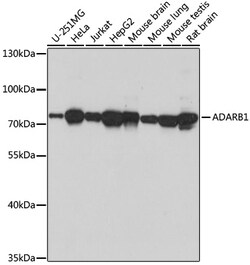Learn More
Invitrogen™ ADARB1 Polyclonal Antibody
Rabbit Polyclonal Antibody
Supplier: Invitrogen™ PA5116693
Description
Positive Samples: U-251MG, HeLa, Jurkat, HepG2, mouse brain, mouse lung, mouse testis, rat brain Immunogen sequence: FETPDKAEPP FYVGSNGDDS FSSSGDLSLS ASPVPASLAQ PPLPVLPPFP PPSGKNPVMI LNELRPGLKY DFLSESGESH AKSFVMSVVV DGQFFEGSGR NKKLAKARAA QSALAAIFNL HLDQTPSRQP IPSEGLQLHL PQVLADAVSR LVLGKFGDLT DNFSSPHARR KVLAGVVMTT GTDVKDAKVI SVSTGTKCIN G.
Catalyzes the hydrolytic deamination of adenosine to inosine in double-stranded RNA (dsRNA) referred to as A-to-I RNA editing. This may affect gene expression and function in a number of ways that include mRNA translation by changing codons and hence the amino acid sequence of proteins; pre-mRNA splicing by altering splice site recognition sequences; RNA stability by changing sequences involved in nuclease recognition; genetic stability in the case of RNA virus genomes by changing sequences during viral RNA replication; and RNA structure-dependent activities such as microRNA production or targeting or protein-RNA interactions. Can edit both viral and cellular RNAs and can edit RNAs at multiple sites (hyper-editing) or at specific sites (site-specific editing). Its cellular RNA substrates include: bladder cancer-associated protein (BLCAP), neurotransmitter receptors for glutamate (GRIA2 and GRIK2) and serotonin (HTR2C), GABA receptor (GABRA3) and potassium voltage-gated channel (KCNA1). Site-specific RNA editing of transcripts encoding these proteins results in amino acid substitutions which consequently alter their functional activities. Edits GRIA2 at both the Q/R and R/G sites efficiently but converts the adenosine in hotspot1 much less efficiently. Can exert a proviral effect towards human immunodeficiency virus type 1 (HIV-1) and enhances its replication via both an editing-dependent and editing-independent mechanism. The former involves editing of adenosines in the 5'UTR while the latter occurs via suppression of EIF2AK2/PKR activation and function. Can inhibit cell proliferation and migration and can stimulate exocytosis.
Specifications
| ADARB1 | |
| Polyclonal | |
| Unconjugated | |
| ADARB1 | |
| 1700057H01Rik; Adar2; Adarb1; adenosine deaminase, RNA specific B1; adenosine deaminase, RNA-specific, B1; adenosine deaminase, RNA-specific, B1 (homolog of rat RED1); adenosine deaminase, RNA-specific, B1 (RED1 homolog rat); AW124433; AW558573; BB220382; D10Bwg0447e; Double-stranded RNA-specific editase 1; DRABA2; DRADA2; dsRNA adenosine deaminase; dsRNA adenosine deaminase DRADA2; Red1; RED1 homolog; RNA editase; RNA editing deaminase 1; RNA editing deaminase of glutamate receptors; RNA-editing deaminase 1; RNA-editing enzyme 1 | |
| Rabbit | |
| Affinity chromatography | |
| RUO | |
| 104, 110532, 25367 | |
| -20°C, Avoid Freeze/Thaw Cycles | |
| Liquid |
| ELISA, Western Blot | |
| 0.94 mg/mL | |
| PBS with 50% glycerol and 0.01% thimerosal; pH 7.3 | |
| P51400, P78563, Q91ZS8 | |
| ADARB1 | |
| Recombinant fusion protein containing a sequence corresponding to amino acids 180-380 of human ADARB1 (NP_0011031). | |
| 100 μL | |
| Primary | |
| Human, Mouse, Rat | |
| Antibody | |
| IgG |
Your input is important to us. Please complete this form to provide feedback related to the content on this product.
